
Salix alba, the white willow, is a species of willow native to Europe and western and central Asia. The name derives from the white tone to the undersides of the leaves.

Salix caprea, known as goat willow, pussy willow or great sallow, is a common species of willow native to Europe and western and central Asia.

Salix purpurea, the purple willow, purpleosier willow, or purple osier, is a species of willow native to most of Europe and western Asia north to the British Isles, Poland, and the Baltic States.

Salix viminalis, the basket willow, common osier or osier, is a species of willow native to Europe, Western Asia, and the Himalayas.
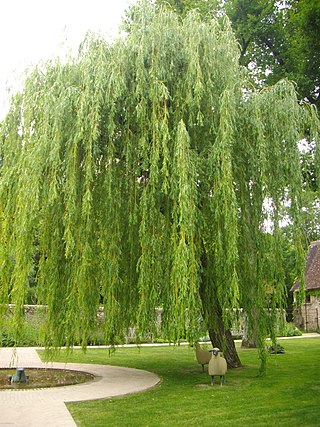
Salix babylonica is a species of willow native to dry areas of northern China, but cultivated for millennia elsewhere in Asia, being traded along the Silk Road to southwest Asia and Europe.
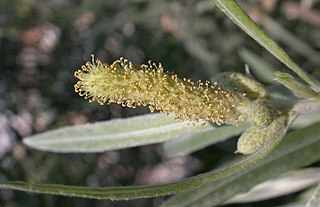
Salix exigua is a species of willow native to most of North America except for the southeast and far north, occurring from Alaska east to New Brunswick, and south to northern Mexico. It is considered a threatened species in Massachusetts while in Connecticut, Maryland, and New Hampshire it is considered endangered.

Salix myrsinifolia, known as the dark-leaved willow or myrsine-leaved willow, is a species of willow native to Europe and Western Siberia. It forms a 2–5 m (6.6–16.4 ft) high shrub. In the north it often becomes a tree up to 8 m (26 ft) tall.

Salix lanata, the woolly willow, is a subarctic species of willow native to Iceland, the Faeroe Islands and Finland, through to eastern Siberia. In Scotland it can be found in only a few localities of Perthshire, Angus and Aberdeenshire, generally on rocky mountain sides at altitudes of 600–900 m (1,969–2,953 ft).

Salix eleagnos the bitter willow, olive willow, hoary willow, rosemary willow, or elaeagnus willow, is a species of flowering plant in the family Salicaceae, native to central and southern Europe and south west Asia. Growing to 3 m (10 ft) tall by 5 m (16 ft) broad, it is an erect bushy deciduous shrub with narrow grey-green leaves up to 20 cm (8 in) long, which turn yellow in autumn (fall). The green catkins, 3–6 cm (1–2 in) long, appear with the leaves in spring, male catkins having yellow anthers.
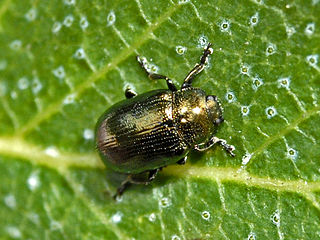
Phratora vitellinae, the brassy leaf beetle, formerly Phyllodecta vitellinae, is a beetle of the family Chrysomelidae found in Europe and Asia. It feeds on Populus and Salix species. The evolution of its host plant preferences and the mechanism by which it uses host plant chemicals to make a larval defensive secretion have been the subject of intense study by research groups in Europe and the Nordic countries.

Salix commutata, the undergreen willow, is a plant species native to western Canada and the north-western United States. It has been reported from Alaska, Yukon, the Northwest Territories, British Columbia, Alberta, Saskatchewan, Montana, Idaho. Washington and Oregon. It grows on rocky alpine and subalpine slopes, conifer forests, stream banks, bogs, etc.

Salix daphnoides, the European violet willow, is a species of plant in the family Salicaceae. It can grow as a large shrub or small tree, normally reaching a height of 6–8 m (20–26 ft), but can grow up to 12 m (39 ft) tall.

Salix glabra, the smooth willow, is a small shrub from the genus of willow (Salix). It is found in the mountainous areas of several European countries.

Salix appendiculata is a plant from the willow genus (Salix). They can be found in France, Italy, Central and Eastern Europe, and on the Balkan Peninsula.

Salix kirilowiana is a willow species described by Sergei Sergeyevich Sheglejev. Salix kirilowiana is part of the genus Salix, and the family Salicaceae. No subspecies are listed in the Catalog of Life.
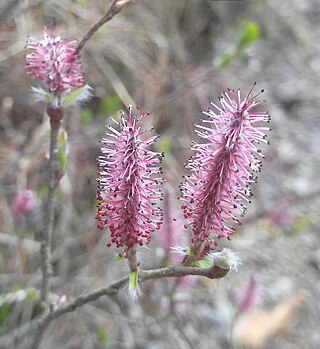
Salix saxatilis is a willow species described by Porphir Kiril Nicolai Stepanowitsch Turczaninow.
Salix athabascensis is a species of willow first described by Hugh Miller Raup.

Phratora tibialis is a species of leaf beetle found in Europe and parts of Asia. This beetle is found on willows and the chemistry and production of its larval defensive secretions and host plant relationships have been studied extensively.
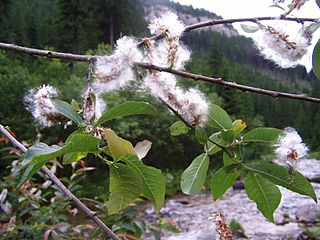
Salix silesiaca, the Silesian willow, is a species of flowering plant in the family Salicaceae. It is native to the Sudeten and Carpathian Mountains, and the mountains of the Balkan Peninsula. A shrub reaching 6 ft (2 m), it is considered to be a member of the informal sallow group.
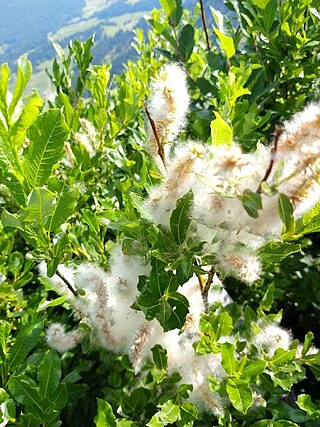
Salix foetida, the fishy willow, is a species of flowering plant in the family Salicaceae, native to the Alps, Pyrenees, and central Apennine Mountains of Europe. It is found only on continuously moist scree up to 2,600 m (8,500 ft) above sea level.




















